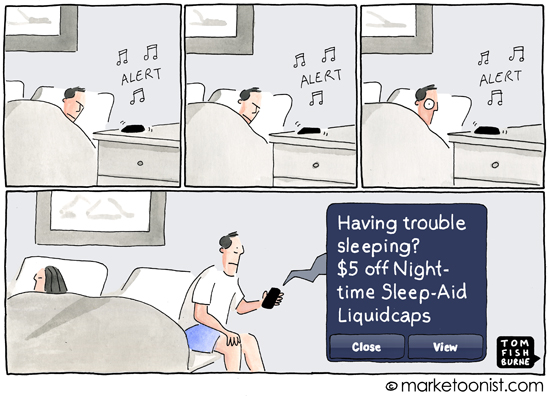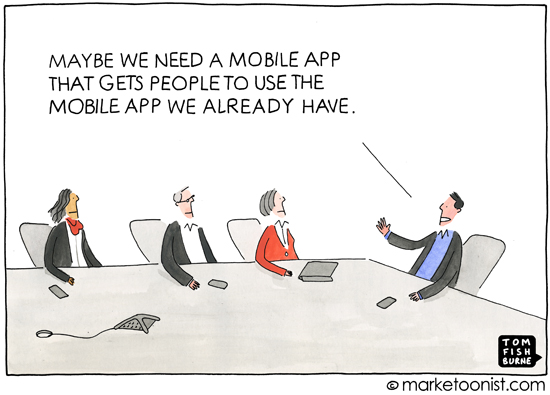What is the difference between mobile reading and desktop?
If you are already preparing to release a mobile application, then you probably thought about how to adapt your content to the mobile user experience. Where to start?
Communicate with users effectively

Nobody likes annoying push notifications, so watch out for their frequency. Each notification should be of value to the mobile experience, the user or your product. As a rule, messages in push notifications are informative or entertaining.
Build User-Oriented Functionality
Remember the small screen, the wide range of technical features of mobile devices, the inaccessibility of the Internet in certain areas, as well as the features of scrolling with your finger. The priority should be content that is especially valuable precisely in the framework of using a mobile application. For example, you can add a click-to-call link to your support phone numbers in the contacts section. If certain functionality just does not fit in your mobile application, do not worry, you can always send your customers to the site or to another appropriate channel.
Improve the look of your content
Remember that your users may prefer horizontal reading to vertical reading, because they are more familiar with them from their previous desktop experience. You've probably heard about the three-click rule, which emphasizes the need to reduce the number of clicks and finger clicks to a minimum.
A study by User Interface Engineering shows that users do not necessarily leave the application after three clicks, but they should still have a clear understanding that they are close to completing the task. The most valuable content that you really want to show to users should be located as close as possible to the start page and even on it.
Work on navigation
Users always need an understandable “beacon” that tells them exactly where they are in the application, how they can go back or start and how they can move on - make sure that they can get anywhere in the application, back and forth.
Developing for a mobile screen involves certain difficulties, so save space and time using simple and universal icons (for example, a house for Home or the left and right arrows to move forward and backward). Navigation links and elements should have short and clear descriptions.
Engage users with good content

Depending on the specifics of your product or service, the mix of content presented in your mobile application should be balanced and include support, product guide, contact information, marketing materials and instructions, if necessary. Remember that multimedia content (especially with movement that distracts the user) is more suitable for entertainment or providing instructions.
Give users control over audio and video. Make sure your images are scaled for small screens and have sufficient resolution for Retina screens. Most likely, on the go, mobile users will not be able to read the content well, so the main ideas need to be presented briefly and clearly.
Rebuild mobile design for easy reading
It's funny that so far a message has appeared on the sites of some top brands demanding to install Flash to view content on the iPhone. Your formats and design should be a really deep rethinking of your desktop version. Your main goal as a designer is to provide users with good opportunities for scanning content and attract their attention with a clear hierarchy of elements and clarity of presentation. Colors and styles should match the ones you use on your site and other marketing channels. The visual transition elements (gradients, transparency, arrows and contrast) can serve as tips for the user so that you can fully control their line of movement within the application.
Mobile reading as a concept is still evolving, and you can beat the competition by putting yourself in the user's place as much as possible. No doubt this list goes on. I will be waiting for your additions in the comments!
What else would you suggest to create a really good mobile experience?
Communicate with users effectively

Nobody likes annoying push notifications, so watch out for their frequency. Each notification should be of value to the mobile experience, the user or your product. As a rule, messages in push notifications are informative or entertaining.
Build User-Oriented Functionality
Remember the small screen, the wide range of technical features of mobile devices, the inaccessibility of the Internet in certain areas, as well as the features of scrolling with your finger. The priority should be content that is especially valuable precisely in the framework of using a mobile application. For example, you can add a click-to-call link to your support phone numbers in the contacts section. If certain functionality just does not fit in your mobile application, do not worry, you can always send your customers to the site or to another appropriate channel.
Improve the look of your content
Remember that your users may prefer horizontal reading to vertical reading, because they are more familiar with them from their previous desktop experience. You've probably heard about the three-click rule, which emphasizes the need to reduce the number of clicks and finger clicks to a minimum.
A study by User Interface Engineering shows that users do not necessarily leave the application after three clicks, but they should still have a clear understanding that they are close to completing the task. The most valuable content that you really want to show to users should be located as close as possible to the start page and even on it.
Work on navigation
Users always need an understandable “beacon” that tells them exactly where they are in the application, how they can go back or start and how they can move on - make sure that they can get anywhere in the application, back and forth.
Developing for a mobile screen involves certain difficulties, so save space and time using simple and universal icons (for example, a house for Home or the left and right arrows to move forward and backward). Navigation links and elements should have short and clear descriptions.
Engage users with good content

Depending on the specifics of your product or service, the mix of content presented in your mobile application should be balanced and include support, product guide, contact information, marketing materials and instructions, if necessary. Remember that multimedia content (especially with movement that distracts the user) is more suitable for entertainment or providing instructions.
Give users control over audio and video. Make sure your images are scaled for small screens and have sufficient resolution for Retina screens. Most likely, on the go, mobile users will not be able to read the content well, so the main ideas need to be presented briefly and clearly.
Rebuild mobile design for easy reading
It's funny that so far a message has appeared on the sites of some top brands demanding to install Flash to view content on the iPhone. Your formats and design should be a really deep rethinking of your desktop version. Your main goal as a designer is to provide users with good opportunities for scanning content and attract their attention with a clear hierarchy of elements and clarity of presentation. Colors and styles should match the ones you use on your site and other marketing channels. The visual transition elements (gradients, transparency, arrows and contrast) can serve as tips for the user so that you can fully control their line of movement within the application.
Mobile reading as a concept is still evolving, and you can beat the competition by putting yourself in the user's place as much as possible. No doubt this list goes on. I will be waiting for your additions in the comments!
What else would you suggest to create a really good mobile experience?
